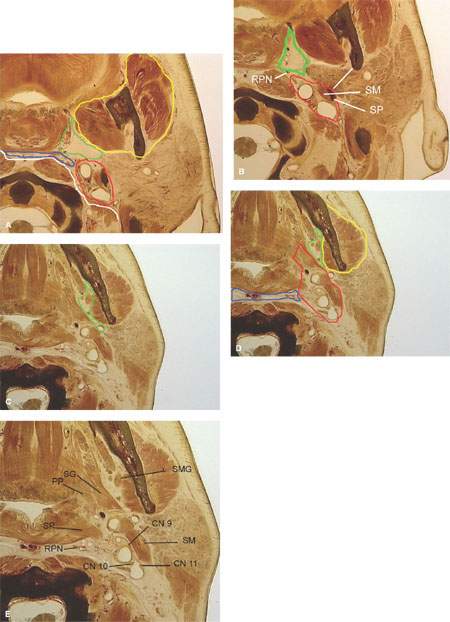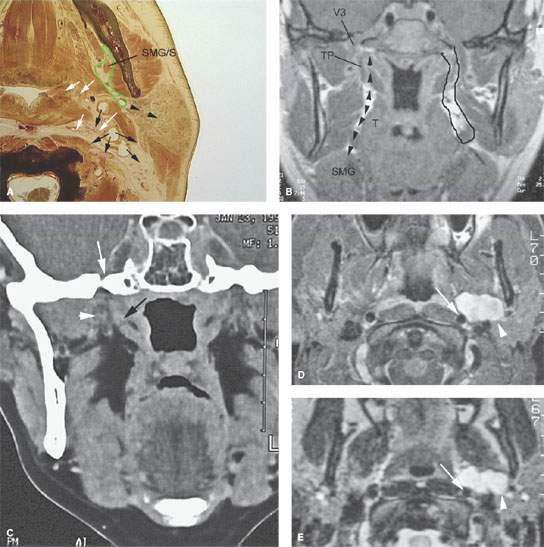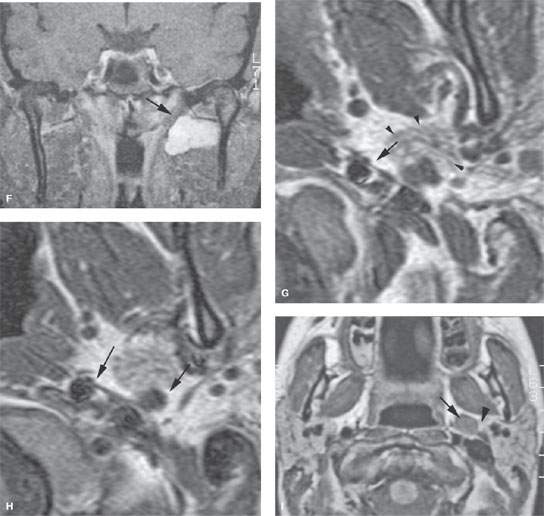PRESTYLOID PARAPHARYNGEAL SPACE MASSES
KEY POINTS
- All masses presenting submucosally around the pharynx or presenting in the deep face should be imaged before they are biopsied.
- Imaging with magnetic resonance and/or computed tomography usually provides the most pivotal information in medical decision making with regard to parapharyngeal masses.
- Such imaging will almost always narrow differential considerations to one or two possibilities in prestyloid parapharyngeal space masses.
- Imaging-guided biopsy is a very useful adjunct in properly selected cases.
INTRODUCTION
The prestyloid parapharyngeal space (PSPS) is discussed in this chapter as the primary site of origin for mass lesions of the head and neck. The PSPS is a secondarily involved site in several common inflammatory and mucosal-origin neoplastic diseases that are discussed in other chapters.
Clinical Presentation
Small masses in the PSPS are typically discovered as incidental findings on studies done for other purposes. The majority of larger lesions are discovered because the patient or a health care provider notices a submucosal bulge along the oropharyngeal wall usually at about the level of the palatine tonsil. Fewer are discovered because of symptoms related to the mass such as those due to eustachian tube obstruction, although cancers can cause pain either due to local effects or skull base invasion and, if they invade adjacent spaces, trismus and rarely cranial neuropathies.
APPLIED ANATOMY
In the suprahyoid neck, the spaces adjacent to the visceral compartment are more numerous and structurally somewhat more complex than they are in the infrahyoid neck. They include the parapharyngeal space (pre- and retrostyloid divisions), retropharyngeal space, prevertebral space, masticator and buccal spaces, parotid gland within its capsule, and the submandibular space (Figs. 142.3–142.7, 143.1, and 143.2). The parotid and submandibular glands are discussed in Chapter 179.
The primary skills necessary to interpret computed tomography (CT) and magnetic resonance (MR) studies of the deep spaces of the face and supra- and infrahyoid neck are common to these areas and include the following:
- Thorough knowledge of the anatomy.
- Realization that the differential diagnosis:
- Is primarily anatomically driven and largely based on analysis of the point of origin and displacement of normal anatomic structures (Fig. 143.1).
- Requires a rudimentary knowledge of developmental disorders.
- Is aided by a familiarity of the morphology of lesions as seen on MR and CT of the more common lesions in each space.
- Must take into account that disease may spread transcompartmentally because the process is aggressive and/or extends along existing anatomic structures (e.g., nerve, vessel, muscle bundles, and lymphatics).
- Is primarily anatomically driven and largely based on analysis of the point of origin and displacement of normal anatomic structures (Fig. 143.1).
Spatial Boundaries
The PSPS is separated from the retrostyloid parapharyngeal space (RSPS) by the musculofascial sheath associated with the stylopharyngeus, styloglossus, and stylohyoid muscles. It contains fat, the ascending pharyngeal neurovascular bundle, and most cephalad the tensor muscle of the palate (Figs. 142.3–142.5, 143.1, and 143.2). The tensor muscle of the palate is at the borderlands of the masticator space and RSPS. The space comes into contact directly with the central skull base medial to the foramen ovale and is continuous with the submandibular space inferiorly (Figs. 143.1 and 143.2). The third division of the trigeminal nerve is more related to the adjacent but separate masticator space.
The PSPS comes into contact with the central skull base medial to the foramen ovale. Inferiorly, the PSPS is contiguous with the submandibular space, explaining why masses in this space are frequently approached by removal of the submandibular gland and cephalad dissection to the PSPS via the submandibular space (Figs. 143.1 and 143.2).
Structures of Interest
The analysis of a mass in the PSPS depends on a thorough understanding of the PSPS relationship to the following structures (Figs. 143.1 and 143.2):
Superiorly: Central skull base mainly medial to foramen ovale (Fig. 143.2)
Inferiorly: Submandibular space (Fig. 143.2)
Anteriorly: Pterygoid plates, posterior maxilla, and anterior tonsillar pillar
Posteriorly: Styloid musculature and structures in the RSPS (Fig. 143.1); more laterally, mainly the carotid artery and jugular vein and, more medially, the lateral retropharyngeal lymph nodes and cervical sympathetic trunk
Medially: Pharyngeal constrictors and palatal muscles (Figs. 143.1 and 143.2)
Laterally: Deep portion of the parotid gland and stylomandibular tunnel (Figs. 143.1 and 143.2)

FIGURE 143.1. Whole organ sections showing anatomic relationships of the spaces in the suprahyoid neck in relationship to the prestyloid parapharyngeal space (PSPS) and retrostyloid parapharyngeal space (RSPS). A: Section at the mid palatine tonsillar level. The retropharyngeal space is outlined in blue and the prevertebral space in white. The parapharyngeal space is divided into the prestyloid component outlined in green and the retrostyloid component outlined in red. The masticator space is outlined in yellow. B: A section featuring the anatomy of the parapharyngeal space and contained adjacent structures. This is a magnified image of that seen in (A). The PSPS is outlined in green and the retrostyloid space in red. Note the position of the retropharyngeal lymph node (RPN) relative to the two spaces. Also note the important landmarks separating these two spaces—the styloid process (SP) and the styloid musculature (SM). The white line drawn between the styloid processes and the mandibular ramus defines the stylomandibular tunnel. The parotid gland deeper portion typically protrudes through this gap. C: A more inferior section showing, as isolated, the PSPS relationship to the styloid musculature and how it is contiguous with the submandibular space. D: The overall relationship between the PSPS and other deep spaces is demonstrated with color coding of spaces as seen and indicated previously in this figure legend. E: Anatomic diagram showing important anatomic landmarks related to the PSPS and helping to define its relationship with regard to the retrostyloid space. The styloglossus muscle (SG) and palatopharyngeus muscle (PP) divide the prestyloid and retrostyloid spaces. The submandibular gland (SMG) lies at the inferior-most extremity of the PSPS. The stylopharyngeus muscle (SP) further divides the space. The glossopharyngeal nerve (CN9) and vagus nerve (CN10) are shown as markers for the position of the lower cranial nerves within the retrostyloid space. Note that the lateral retropharyngeal node (RPN) lies at the border of the RSPS and the retropharyngeal space and medial to the carotid sheath.


FIGURE 143.2. Anatomic diagrams similar to that seen in Figure 143.1 to demonstrate the anatomic relationships that explain the vectors of travel and displacement of surrounding structures when masses primarily involve the prestyloid parapharyngeal space (PSPS). The PSPS outlined in green and this level show that it is contiguous inferiorly with the submandibular space and contained gland (SMG/S). The black arrowheads indicate that masses arising with this space tend to travel through the stylomandibular tunnel, displacing or involving the parotid gland. The white arrows indicate that the styloid musculature will be displaced medially and somewhat posteriorly by a PSPS mass. The black arrows extending from the structures of the carotid sheath indicate that those structures will most typically be displaced posteriorly and somewhat medially by a prestyloid mass. B: Contrast-enhanced T1-weighted (T1W) coronal magnetic resonance (MR) showing the important relationship between the parapharyngeal space and masticator space as defined by predictable anatomic landmarks. On the right side of the diagram, the PSPS is roughly outlined in black from its uppermost aspect medial to the foramen ovale and its lower aspect contiguous with the submandibular space. On the left side of the diagram, structures outside of the parapharyngeal space are identified by the third division of the trigeminal nerve (V3) and a fascia related to the tensor muscle of the palate (TP). The black arrowheads indicate that these masses extend to the skull base medial to those masticator space anatomic structures and then travel inferiorly to sometimes as low as the submandibular space. C: Contrast-enhanced coronal computed tomography (CT) study showing that CT landmarks for these same structures can be identified, although perhaps somewhat less graphically than on MR at times. The foramen ovale (white arrow) defines the position of the mandibular division of the trigeminal nerve, which is seen below the skull base (white arrowhead). The tensor muscle of the palate is shown by the black arrow, and the fat within the parapharyngeal space is identified as demonstrated in (B). D, E: Contrast-enhanced fat suppressed T1- and T2-weighted image, respectively, showing an incidentally discovered benign mixed tumor in the PSPS. The mass is inseparable from the deep portion of the parotid gland (arrowhead), and from this small mass one can appreciate the eventual posteromedial displacement of the carotid sheath structures (arrow) that will result from a mass arising in that component of the parapharyngeal space. F: Contrast-enhanced T1W coronal image showing the mass extending toward the skull base lateral to the tensor muscle of the palate (black arrowhead), confirming its position in the PSPS. G, H: Contrast-enhanced T1W of another patient with an incidentally discovered benign mixed tumor (arrowheads in A) appearing to arise primarily in the PSPS and separate from the deep portion of the parotid gland. In this early lesion, it is relatively easy to appreciate how when the lesion eventually grows to a larger size it will displace the carotid sheath structures posteriorly and medially (arrows). I: Contrast-enhanced T1W image of yet another patient with a small benign mixed tumor discovered incidentally in the PSPS (arrow), obviously separate from the deep portion of the parotid gland and therefore likely arising from ectopic salivary tissue.
Stay updated, free articles. Join our Telegram channel

Full access? Get Clinical Tree








